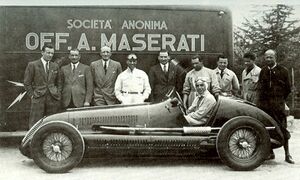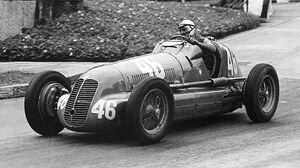(→4CL) |
|||
| Line 40: | Line 40: | ||
== 4CLT/48 == |
== 4CLT/48 == |
||
| + | In 1947 Maserati started experimenting with a 4CLs and a feature from this experimental car was brought to the new 4CLT/48. T denotes the new innovation, a Tubular Chasis and 48 denotes 1948. |
||
| + | The new car produced 260BHP, an increase in 40BHP from the previous model, brought by the introduction of a Twin-Supercharger |
||
| + | |||
| + | The 4CLT/48 was sometimes refered to as the Sanremo, after winning at the circuit on its debut. Alberto Ascari's victory at the 1948 Sanremo Grand Prix was followed by wins for Reg Parnell and Luigi Villoresi. The car took six wins in 1948. |
||
| + | |||
| + | The race winning form continued into 1949 with victories at 9 of the first 15 races of the season including Toulo de Graffenried winning at the British Grand Prix but the rest of the season saw a resurgence from the Ferrari and Talbot-Lago teams. |
||
| + | |||
| + | In 1950 the World Championship was launched and Alfa Romeo brought huge upgrades to their 158 and relaunched the factory team. In reaction to this Maserati fitted bigger superchargers to their car, bringing the pre-war design up to 280BHP and shed some weight but the performance was not there. The season's only Formula One wins came in non-Championship events. whilst The Milano team modified a 4CLT for use in 1950 and 1951, but without success. |
||
| + | |||
| + | In 1951, Prince Bira relaunched his own team and modified his 4CLT/48 to accept a naturally aspirated OSCA V12 engine. This engine developed around 300 bhp and won the Goodwood race early in the season, but in its only World Championship appearance, at the 1951 Spanish Grand Prix, it retired on the first lap. |
||
| + | |||
| + | The 4CLT/48's best Grand Prix result was achieved by Louis Chiron at the 1950 Monaco Grand Prix, surviving the first lap incident, the Monegasque driver brought his car home 3rd. |
||
== 4CLT/50 == |
== 4CLT/50 == |
||
Revision as of 11:33, 5 April 2013
The Maserati 4CL was designed and manufactured in 1939 as a rival to the Alfa Romeo 158 and the various models of the ERA. More powerful, wider, lighter and lower the new 4CL was significantly better than predecessor the Maserati 6CM.
The car was raced largely after the war and dominated GP racing at this time with multiple wins for drivers like Johnnie Wakefield, Luigi Villoresi and Raymond Sommer.
In 1948 a variation, the 4CLT/48 was produced. This was the car largely driven at World Championship events by the leading Maserati entrants and constructors but some 4CL models were still present. A later model which also featured in Formula 1 was the 4CLT/50.
During 1950, the various versions of the Maserati 4CL were the most populist on the grid with its entrants starting 33 races from the six rounds they competed in.
4CL

Villoresi and the Officine Alfieri Maserati team

1946 Nuvolari GP des Nations
As the 1930's arrived, motorsport started getting more competitive and the Maserati brothers looked to build a replacement of their 6CM model that had enjoyed GP racing success. The cars to beat were the Alfa Romeo 158 and ERA when Maserati launched the new 4CL.
The car had a new inline-4 engine, an improvement of up to 50bhp on the predecessor with a more powerful supercharger. Wider and Lower due to a new suspension layout and Lighter with more aluminium parts, the car was superior to the 6CM.
With star driver Luigi Villoresi, the 4CL took pole position on its debut at the 1939 Tripoli Grand Prix ahead of Mercedes brand new W165, however all four of the new Maserati's retired with engine troubles however two races later, privateer Johnnie Wakefield picked up the cars first victory at the Naples GP. Two more wins were achieved by Wakefield and the factory cars picked up another two before the outbreak of war.
After the war, the Maserati's went through a period of dominance in the absence of the German cars with wins from Luigi Villoresi, Tazio Nuvolari and Giorgio Pelassa but it was in the hands of Frenchman Raymond Sommer that the car was at its most formidable in 1946.
1947 would prove even more successful despite Alfa Romeo fielding the revamped 158, Maserati drivers picked up 10 individual race victories.
In 1948 the Maserati factory team, Oficine Alfieri Maserati and leading Maserati teams switched to the new 4CLT/48, selling their 4CL's to yet more privateer teams and entrants.
4CLT/48
In 1947 Maserati started experimenting with a 4CLs and a feature from this experimental car was brought to the new 4CLT/48. T denotes the new innovation, a Tubular Chasis and 48 denotes 1948.
The new car produced 260BHP, an increase in 40BHP from the previous model, brought by the introduction of a Twin-Supercharger
The 4CLT/48 was sometimes refered to as the Sanremo, after winning at the circuit on its debut. Alberto Ascari's victory at the 1948 Sanremo Grand Prix was followed by wins for Reg Parnell and Luigi Villoresi. The car took six wins in 1948.
The race winning form continued into 1949 with victories at 9 of the first 15 races of the season including Toulo de Graffenried winning at the British Grand Prix but the rest of the season saw a resurgence from the Ferrari and Talbot-Lago teams.
In 1950 the World Championship was launched and Alfa Romeo brought huge upgrades to their 158 and relaunched the factory team. In reaction to this Maserati fitted bigger superchargers to their car, bringing the pre-war design up to 280BHP and shed some weight but the performance was not there. The season's only Formula One wins came in non-Championship events. whilst The Milano team modified a 4CLT for use in 1950 and 1951, but without success.
In 1951, Prince Bira relaunched his own team and modified his 4CLT/48 to accept a naturally aspirated OSCA V12 engine. This engine developed around 300 bhp and won the Goodwood race early in the season, but in its only World Championship appearance, at the 1951 Spanish Grand Prix, it retired on the first lap.
The 4CLT/48's best Grand Prix result was achieved by Louis Chiron at the 1950 Monaco Grand Prix, surviving the first lap incident, the Monegasque driver brought his car home 3rd.
4CLT/50
Race Victories
| Year | Event | Driver | Notes |
|---|---|---|---|
Complete Formula One Results
| Year | Driver | Tyre | 1 | 2 | 3 | 4 | 5 | 6 | 7 | 8 | 9 | 10 | 11 | 12 | 13 | 14 | 15 | 16 | 17 | 18 | 19 | 20 |
|---|---|---|---|---|---|---|---|---|---|---|---|---|---|---|---|---|---|---|---|---|---|---|
